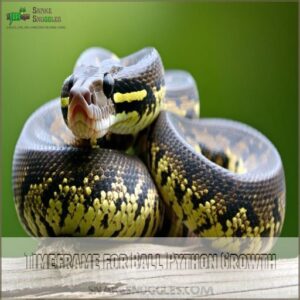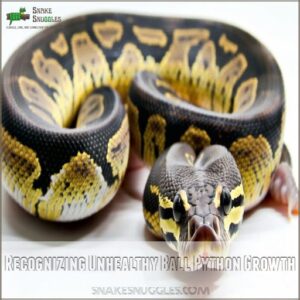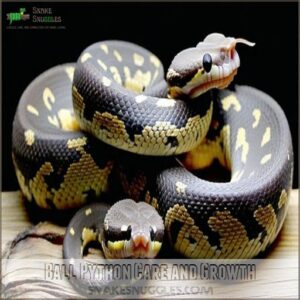This site is supported by our readers. We may earn a commission, at no cost to you, if you purchase through links.
 Ball pythons are like the Goldilocks of snakes—not too big, not too small.
Ball pythons are like the Goldilocks of snakes—not too big, not too small.
Typically, you’ll see males measuring between 2.5 to 3.5 feet, while females, the overachievers of the ball python world, can stretch out to 4–6 feet.
It’s a bit like watching them grow up as they usually reach full size in about two to three years.
Of course, a good diet and cozy home can make a real difference in how big your scaly buddy gets.
Stay tuned for tips on creating the perfect python paradise to help them thrive even more!
Table Of Contents
- Key Takeaways
- Ball Python Growth Rate
- How Big Do Ball Pythons Get
- Factors Affecting Ball Python Size
- Ball Python Growth Chart
- Timeframe for Ball Python Growth
- Ball Python Weight and Length
- Recognizing Unhealthy Ball Python Growth
- Ball Python Care and Growth
- Frequently Asked Questions (FAQs)
- How long do ball pythons grow?
- How big is a ball python?
- How long does it take a ball python to hatch?
- How big do pythons get?
- What factors affect a ball python’s adult size?
- When do ball pythons reach adulthood?
- How long does it take a ball python to get full size?
- How big is a full grown ball python?
- Do ball python bites hurt?
- How fast is a full grown python?
- How often should a ball python eat?
- What is the ideal ball python enclosure size?
- Can diet affect a ball python’s growth?
- How to tell if a ball python is healthy?
- Do male and female ball pythons differ in behavior?
- Conclusion
Key Takeaways
- You’ll find that ball pythons grow to about 3 to 5 feet in length, with females generally becoming larger than males.
- It takes around 3 to 5 years for a ball python to reach full maturity, so patience is essential in monitoring their development.
- Diet, genetics, and proper care significantly influence the growth rate and final size of your ball python. Providing a suitable enclosure, such as one that meets the recommended terrarium size for ball pythons, also plays a crucial role in your pet’s development.
- Tracking your python’s growth using a growth chart helps you ensure it’s healthy and spot potential issues early.
Ball Python Growth Rate
You’ll find that ball pythons are slow and steady growers, reaching their adult size in about three to five years.
Several factors, like diet and genetics, influence their growth rate, so it’s like watching a slow-motion race where each snake finds its own pace.
Factors Influencing Growth Rate
The saga of ball python growth is a tale where genetics, diet, temperature, and humidity play starring roles.
Imagine these elements as the directors of your snake’s growth story.
Just like us, stress can throw their growth off balance.
Keep an eye on their environment and habits to make sure your ball python grows strong and healthy.
Average Growth Rate in Captivity
Ball pythons grow steadily, usually achieving their full size by age five.
In captivity, their growth rate varies depending on factors like genetics, diet, and care.
You can use a ball python growth calculator to track your snake’s progress and make sure it’s growing at a healthy pace.
Did you know females often outgrow males?
Regular feeding plays a big role, too.
Tracking these changes helps you notice any unusual shifts that could indicate health issues.
So, keep an eye on growth!
Signs of Healthy Growth
Curious if your ball python’s thriving? Look for signs of healthy growth.
Steady weight gain, a regular shedding pattern, and a strong appetite signal a happy snake.
Watch those energy levels, too! A sluggish python might need some TLC.
Remember, a sleek body condition—not too plump, not too lean—is your goal.
Treat your python with care, and it’ll flourish!
How Big Do Ball Pythons Get
When you’re thinking about ball pythons, picture these charming snakes growing to impressive lengths of three to five feet.
With such sizes, it’s as if they’re trying to be the stars of their own reptile fashion show!
Ball Python Size by Age
Watching your ball python grow is like seeing nature’s slow magic trick unfold.
Hatchlings start out small—about the size of a pencil at 10 inches long.
By 6 months, they’re 1.5-2 feet, a curious squiggle of growth milestones.
A year old brings more impressive dimensions, flaunting 2-2.5 feet.
Each age marks a new chapter in the snake’s growth story.
Average Adult Ball Python Size
So, you’ve tracked your little one’s growth—amazing! Now, what’s the average adult size? Most adult ball pythons settle in at 3-5 feet long. Females tend to be chunkier than males. Their weight? Think 1600-2700 grams, give or take. Remember, size variations happen.
- It’s like snowflakes – no two are exactly alike!
- Proper housing is key to their comfort and growth.
- A healthy weight range guarantees a long and happy life.
- Their size impacts how much they eat—and what they eat!
Maximum Ball Python Size
While adult ball pythons can reach impressive lengths, what defines their maximum size?
Genetics play a tricky role—like lottery-winning DNA—where morph influences and regional differences can swing the size game.
Females often outgrow their male counterparts, sometimes stretching up to five feet.
Unraveling these size variations is like untangling a mystery, with gender impacting the final measurement.
Hatchling Size and Weight
When baby ball pythons arrive, they’re tiny yet fascinating. You’ll notice they usually weigh between 60-100 grams.
Here’s a quick rundown:
- Hatchling Weight Variation: Each is unique, like snowflakes.
- Hatchling Growth Stages: They grow quickly!
- Hatchling Feeding Guidelines: Feed small mice every 4-5 days.
- Hatchling Handling Tips: Gentle handling helps build trust.
Juvenile Size and Weight
As your ball python grows from a hatchling, it enters the juvenile stage, typically reaching 1.5 to 2 feet and weighing 200 to 350 grams.
This rapid change means adjusting their enclosure size and feeding routine.
Keep an eye on growth milestones while monitoring weight and diet to make sure healthy development.
Remember, they’re getting bigger, stronger, and hungrier!
| Age | Length | Weight | Enclosure Size |
|---|---|---|---|
| 6 Months | 1.5-2 feet | 200-350 g | 20-30 gallons |
| 1 Year | 2-2.5 feet | 350-550 g | 30-40 gallons |
| 15 Months | 2.5-3 feet | 550-800 g | 40+ gallons |
| 18 Months | 3+ feet | 800-1000 g | 50+ gallons |
Subadult Size and Weight
Subadult ball pythons keep you on your toes.
They’re typically around 2.5 to 3.5 feet long and weigh 550 to 1000 grams.
At this stage, they need proper subadult feeding and an adequately sized enclosure to support their continued growth rate.
Handling techniques evolve too; these snakes are gaining strength like a teenager mastering a skateboard.
Adult Size and Weight
You’ve probably wondered how big adult ball pythons can get.
These guys often weigh between 1,200 and 2,500 grams, with females usually being heftier than the males.
Imagine a 5-foot snake lounging in your living room!
Their size can hinge on:
- Sex differences
- Weight variation
- Enclosure size
- Health impacts
Keep these factors in check.
Factors Affecting Ball Python Size
When you’re raising a ball python, its final size isn’t just a roll of the dice; it hinges on factors like genetics, diet, and living conditions.
Think of these elements as the secret ingredients in a snake growth smoothie, where each part plays a key role in achieving the perfect python proportion.
Genetics and Size
So, you’ve figured out how big your ball python might get, but genetics play a huge role!
Some snakes are naturally larger than others, thanks to their genes.
Think of it like family trees; size can be inherited.
Different morphs, or color variations, sometimes come with size differences too.
Let’s explore this with a handy guide!
| Morph | Average Adult Size (Females) | Average Adult Size (Males) | Size Variation |
|---|---|---|---|
| Normal | 4-5 feet | 3-4 feet | Moderate |
| Pastel | 4-5 feet | 3-4 feet | Moderate |
| Albino | 4-5 feet | 3-4 feet | Moderate |
| Spider | 3.5-4.5 feet | 3-3.5 feet | Moderate |
| Banana | 4-5 feet | 3-4 feet | Moderate |
Breeding programs influence this, selecting for specific traits, including size.
It’s a fascinating mix of nature and nurture!
Diet and Nutrition
Just like humans need a balanced diet, a ball python’s growth rate is affected by its feeding schedule, with hatchlings fed every 5-7 days, your ball python’s size is impacted by what it eats.
A feeding schedule helps manage prey size and prevents nutritional deficiencies.
Toss in a touch of variety with occasional supplements.
When your snake’s diet sings in harmony, it grows healthy.
Think of it as a gourmet meal keeping them slithering happily!
Enclosure Size and Space
A suitable ball python enclosure, such as a front-opening PVC enclosure, is really important for your ball python’s growth.
Imagine living in a tiny box—it’d cramp anyone’s style!
Adequate space requirements make sure your snake’s comfort without overwhelming them.
Opt for tank sizes that match their stage—hatchlings in smaller habitats, adults in spacious setups.
Balance in habitat design is key to keeping them healthy and content.
Health Issues and Size
Your ball python’s size isn’t just about its genetics or diet; health issues like snake anorexia risks can throw a wrench in growth as well.
Growth stunting might signal a hidden illness.
Obesity risks increase with overfeeding, while being underweight might hint at stress or improper nutrition.
Keep an eye on enclosure impact and aim for the best conditions to create a healthy, happy snake.
Ball Python Growth Chart
You might be wondering just how to keep track of your ball python’s growth, ensuring they reach their full potential.
Creating a growth chart helps you monitor changes in size and weight, shedding light on any unexpected trends that might pop up.
Creating a Growth Chart
Crafting a ball python growth chart is like creating a map for their journey to adulthood.
Use growth chart tools to track progress and interpret weight trends and growth patterns.
It’s not rocket science; it’s a playful way to gauge if they’re thriving.
Imagine your scales boasting, "I know this snake’s secrets!" and you’ve engaged science with fun!
Tracking Growth and Weight
Craft a ball python growth chart to keep tabs on your slinky buddy’s development.
It’s not just about jotting down numbers; it’s a way to witness progress and catch potential issues early.
Regular weight checks guarantee your snake’s growth aligns with healthy benchmarks.
Think of it as the snake version of a fitness tracker—a little humorously, of course!
Identifying Patterns and Trends
By carefully reviewing your ball python’s growth chart, you’ll spot some interesting trends. Look for consistent increases in weight and length. Unexpected dips or plateaus might signal a problem.
Here’s what to watch for:
- Consistent, steady growth.
- Sudden weight loss or gain.
- Changes in eating habits.
- Lethargy or unusual behavior.
These patterns offer clues to your snake’s health and well-being.
Timeframe for Ball Python Growth
Watching your ball python grow can be as exciting as watching paint dry, but fear not—before you know it, they’ll reach their full size in about 3 to 5 years.
Each milestone marks an inch or two of progress, so keep an eye on those scales!
How Long to Reach Full Size
It takes about 3-5 years for a ball python to hit full size.
Think of their growth as a marathon, not a sprint.
Here’s a handy table to keep you on track:
| Age | Length | Weight |
|---|---|---|
| Hatchling | 0.8-1 ft | 60-100 grams |
| 1 Year | 2-2.5 ft | 350-550 grams |
| Adult | 3-5 ft | 1200-2700 grams |
Keep tabs on their progress to make sure they’ve a healthy journey!
Milestones and Developmental Stages
- Hatchling Development: Tiny and curious, they start under a foot, packed with potential. As you care for your ball python, considering their long and healthy lifespan factors early on is vital for a happy pet.
- Juvenile Growth: Watch them lengthen into sleek juveniles.
- Subadult Stage: Gaining size and sass.
- Adult Maturity: Fully grown, they’re a sight to behold, perhaps ready for breeding adventures!
Factors Affecting Growth Rate
Now you know the milestones, let’s tackle factors affecting growth.
Temperature and humidity play roles; like Goldilocks, ball pythons need conditions just right.
Stress? It’s no good—happy snakes grow well.
Genetics set the stage, but diet steals the show. Feed them right, and watch them flourish. Balance is key—think you can handle it?
Ball Python Weight and Length
When you’re raising a ball python, understanding how hefty or lengthy your scaly friend can get is important for its care.
These snakes mightn’t sprout overnight like beanstalks, but they do have their own unique growth spurt patterns, reaching impressive sizes if nurtured just right.
Average Weight and Length
A ball python’s average size can surprise you if you’re expecting a small snake.
These slithering wonders grow to about 3-5 feet, weighing anywhere from 1200 to 1600 grams for males and up to 2500 grams for females.
Growth comparison reveals significant weight variation, influenced by sex differences.
Whether it’s diet or genetics, each character plays a part!
Weight and Length by Age
So, you know your ball python’s average weight and length? Great! Let’s look at how that changes with age.
Think of it like a growth chart for your scaly buddy.
Youngsters pack on weight fast—a few hundred grams in months. By a year, they’ve more than doubled their hatchling weight!
Growth slows down later, reaching a plateau in a few years.
Tracking these changes helps make sure your snake thrives.
Sex Differences in Weight and Length
While you assess your ball python’s size, consider sex-specific growth rates.
Female vs. male differences are important—females typically grow larger, reaching 3.5-5 feet, while males often top out around 3-4 feet.
Compared to boa constrictors, which can reach average lengths of 6-10 feet on record, ball pythons are generally smaller.
These size differences can impact breeding implications and highlight morphological variations.
Picture your python as a distinct individual, much like siblings with unique growth spurts!
Recognizing Unhealthy Ball Python Growth
Spotting unhealthy growth in your ball python is like finding a needle in a haystack, but it’s essential for their wellbeing.
Unexpected weight loss or gain, which could indicate underlying health issues that need attention.
Signs of Obesity
If your ball python’s starting to look like it’s swallowed a football, you might’ve an overfeeding problem on your hands.
A good resource to help you determine if your ball python is the right weight for its age is a ball python weight chart, as it can help you understand if your snake is overweight.
Watch out for a bloated appearance, diminished activity, and sluggishness—all signs of obesity.
Effective weight management includes monitoring diet and signs of metabolic issues, ensuring your snake stays sleek and healthy, not sluggish and slow.
Signs of Underweight
Noticing your ball python looking a bit too slim?
Signs of being underweight include weight loss, a poor appetite, or skin issues like wrinkles.
Lethargy, sunken eyes, and prominent ribs are clues too.
Imagine your snake as a deflated balloon—just not quite right.
Keep an eye on their diet and environment to make sure they’re thriving.
Recognizing Health Issues
Spotting health issues in ball pythons is like catching the early warning signs in a mystery novel.
Watch out for three things: 1. Growth stunting or unexpected weight loss, which might signal trouble. Recognizing these signs is important, especially considering that ball python age milestones can greatly impact a snake’s development.
- Shedding issues or appetite changes, indicating discomfort.
- Behavioral shifts, such as increased hiding, can reveal stress.
Your keen eye is your python’s best ally!
Ball Python Care and Growth
When you’re caring for a growing ball python, it’s all about creating the perfect habitat and making sure their diet’s on point.
Think of it like preparing a cozy little hotel with room service suited to their needs,
ensuring your scaly friend thrives without a hitch.
Providing a Suitable Environment
Providing a suitable environment is key to your ball python’s growth.
Think of their enclosure as their tiny apartment; it needs the right size, temperature, and humidity.
A proper substrate, like aspen shavings, keeps things comfy.
Don’t forget a water bowl!
Consistent temperature and humidity are essential – they’re not fans of drastic changes.
According to the ball python growth stages, a properly sized enclosure (depending on age) prevents stress, which promotes healthy growth, especially during the dramatic size and behavior changes seen in the juvenile stage visit Ball Python Time to Grow for more details.
A properly sized enclosure (depending on age) prevents stress, which promotes healthy growth.
Feeding and Nutrition
It’s essential to provide a balanced diet, considering factors like gut loading prey for optimal nutrition, as discussed in the ball python diet guide. You’ve got to keep an eye on your ball python’s diet. Feed them appropriately sized prey about 1 to 1.25 times their midsection girth.
- Hatchlings need meals every 4-5 days.
- Adults should eat every 7-10 days.
- Watch for overfeeding to avoid obesity.
- Consider nutritional supplements to make sure they get a well-rounded diet.
Balance is key to healthy growth!
Handling and Stress
Handling your ball python can feel like a dance—smooth and careful.
Too much handling feels like daily gym class, stressing them out.
Notice stress signs: they might act jumpy or hissy. Limit handling frequency to a few times a week.
Use gentle handling techniques, letting them slither over your hands.
An appropriate enclosure reduces stress, providing a comforting home.
Frequently Asked Questions (FAQs)
How long do ball pythons grow?
Imagine watching a slow-motion movie: that’s how ball pythons grow, taking about 3-5 years to reach full maturity.
Picture these charming creatures gradually stretching to impressive lengths, maturing steadily with every inch and scale.
How big is a ball python?
At full maturity, ball pythons range from 3 to 5 feet long.
Females grow larger than males, reaching up to 2,500 grams, while males max out at around 1,500 grams.
They typically reach full size by age five.
How long does it take a ball python to hatch?
Ball pythons are carnivores and do not eat eggs in the wild or in captivity, instead they thrive on frozen rodents diet. Ball python eggs typically hatch in 50-70 days. The exact time depends on incubation temperature; it’s a waiting game! Patience is key; soon you’ll have a tiny snake.
How big do pythons get?
When you compare pythons to their ball python cousins, you’ll find their size impressive: they often grow between 12 to 30 feet long, depending on the species.
These giants symbolize the world’s diverse adaptability and resilience.
What factors affect a ball python’s adult size?
Your ball python’s adult size is influenced by genetics, diet, and care.
Feed it appropriately and maintain proper living conditions to support growth.
Females tend to be larger, while frequent feeding accelerates their growth rate.
When do ball pythons reach adulthood?
Typically, ball pythons reach adulthood around 3-5 years.
By this time, females grow 5 to 5 feet long, while males are slightly smaller.
Their slow and steady growth calls for patience and consistent care.
How long does it take a ball python to get full size?
Picture a balloon inflating steadily; that’s how your ball python grows, taking about 3-5 years to reach full size.
They grow to 5-5 feet, with females often tipping the scales heavier and longer than males.
How big is a full grown ball python?
A full-grown ball python typically measures between 3 to 5 feet long.
Females often reach the upper range, weighing 1,600 to 2,700 grams, while males are slightly smaller.
This growth usually occurs by age three to five.
Do ball python bites hurt?
Ball python bites aren’t usually painful; they feel more like a pinch. Their small teeth rarely break skin. Don’t worry, they’re not venomous! However, always handle them carefully.
How fast is a full grown python?
Full-grown pythons, while famed for their stealthy slink, maintain a modest speed of about 1 mile per hour.
They won’t win any races but can surprise you with their efficiency when slipping through their environment.
How often should a ball python eat?
Feed your ball python every 7-10 days.
Hatchlings need meals every 4-5 days, while adults can wait 7-10 days.
Stick to prey that’s 1 to 25 times the snake’s midsection for good health.
What is the ideal ball python enclosure size?
Imagine your ball python in a snug suit:
hatchlings thrive in 10-gallon homes, while juveniles need 20-30 gallons.
Adults enjoy freedom in 40-60 gallons, balancing security with space.
It’s perfect for slithering satisfaction!
Can diet affect a ball python’s growth?
A ball python’s diet plays a key role in its growth, as a proper tank size requirements, such as a 40-gallon tank for adults, ensure the snake’s overall health and well-being. A ball python’s diet plays a key role in its growth.
Regular feeding of appropriately sized prey supports steady development.
Overfeeding can lead to obesity.
Keep meals proportional to the snake’s midsection for healthy growth.
How to tell if a ball python is healthy?
Check your ball python’s health by noting clear eyes, firm skin, and smooth scales.
Healthy snakes are alert, active post-feeding, and shed without problems.
Monitor weight regularly—unexpected changes might indicate health issues needing attention.
Do male and female ball pythons differ in behavior?
Male and female ball pythons are similar in behavior.
They’re typically docile and prefer security in smaller spaces.
Females might be more dominant during breeding, but generally, there’s no major behavioral difference between the sexes.
Conclusion
So, you’ve learned all about how big ball pythons get and how long it takes for them to grow.
Remember, a healthy diet and a comfortable environment are key to your snake reaching its full potential size.
Factors like genetics also play a role in determining the final size of your ball python.
Tracking your snake’s growth, using a chart, helps you monitor its health and spot any issues early.
Understanding the average growth rate and size helps make sure your ball python thrives.
Don’t forget, these fascinating snakes can surprise you!





















